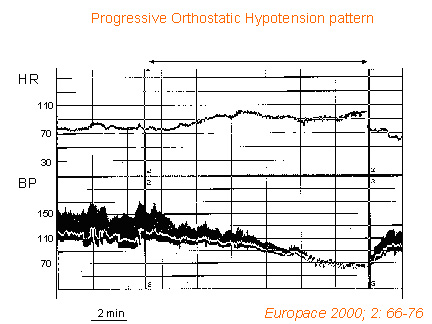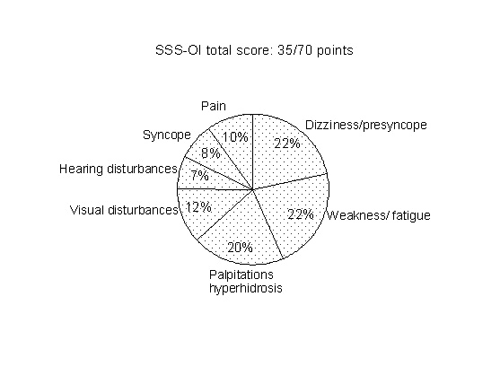Home treatment based on self administered elastic leg stockings seems feasible, safe and well accepted by most patients. If the efficacy of the therapy is confirmed in a larger controlled follow-up study, elastic compression stockings may become a widely used therapy.
Definition and mechanism
Classically, studies dealing with orthostatic intolerance have focused on patients with orthostatic hypotension due to autonomic failure. The definition commonly used of a systolic blood pressure fall >20 mmHg or to below 90 mmHg within 3 minutes (1) comes from a consensus designed to be used in patients with autonomic failure.
Progressive orthostatic hypotension is a condition different from classical “rapid” autonomic failure. Progressive orthostatic hypotension is characterised by a slow progressive decrease in systolic blood pressure (together with compensatory heart rate increases) upon the assumption of a standing position.
Typically these patients remain asymptomatic initially after standing and develop hypotensive symptoms which cause orthostatic intolerance after a few minutes of standing. Progressive orthostatic hypotension differs also from neurally-mediated reflex syncopes because of the absence of vagal bradycardia which usually characterises the vasovagal reflex.
Progressive orthostatic hypotension is commonly seen in the elderly because of age-related impairment in baroreflex mediated vasoconstriction and chronotropic responses of the heart, as well as to the deterioration of the diastolic filling of the heart (2).
In patients with impaired compensatory reflexes the increased downward pooling of the venous blood and the consequent reduction in stroke volume and cardiac output exaggerates the orthostatic fall of blood pressure (2).
Diagnosis
This form of orthostatic hypotension is frequently diagnosed by tilt testing which shows the typical patterns of decreases in systolic blood pressure over several minutes (together with compensatory heart rate increases) (3) (Figure 1), whereas it may remain undetected using the classical criteria for the diagnosis of orthostatic hypotension recommended by the American Autonomic Society (1) because of the lack of significant fall of blood pressure within 3 minutes of standing.

Figure 1. tilt testing in a patient with progressive orthostatic hypotension.
From top to botton are shown heart rate curve and blood pressure curves (systolic, diastolic and mean). There is an absence of adaptation of blood pressure to the upright position. Blood pressure declines slightly and progressively throughout the test and the patient has severe presyncopal symptoms. Heart rate continuously rises untill the end of the test. There is no clear vasovagal reaction.
Clinical features
Progressive orthostatic hypotension is commonly seen in the elderly because of age-related impairment in baroreflex compensatory reflexes to upright position.
These patients usually have one or more associated comorbid conditions and are under treatment with vasoactive drug/s. The cerebral hypoperfusion caused by hypotension leads to inhability to tolerate the standing position and causes important impairment of the quality of life mainly because of dizziness, presyncope, weakness and palpitations.
The most common posturally-related symptoms (4) have been included in a self-administered Specific Symptom Scale questionnaire for Ortostatic Intolerance (SSS-OI) (5). The questionnaire evaluates the following symptoms grouped in 7 items: dizziness and presyncope; visual disturbances (including blurring, color changes, white-out, graying-out, enhanced brightness, darkening or blackening and tunnel vision); syncope; hearing disturbances (including impaired hearing, crackles and tinnitus); pain in the neck (occipital/paracervical and shoulder region), low back pain or precordial pain; weakness, fatigue, lethargy; palpitations and hyperhidrosis. The patients are asked to asses the severity of each of the above symptoms on a visual scale from 0 to 10 (10 maximum entity of the symptom). The sum of scores of the 7 items is the total symptom score (70 maximum score). In the study of Podoleanu et al (5) the mean SSS-OI score was 35 with dizziness, weakness and palpitations accounting for 64% of total score (Figure 2).

Figure 2. Relative weight of the 7 items which form the SSS-IO total score in patients affected by progressive orthostatic hypotension
Clinical features of progressive orthostatic hypotension may mimic those of vasovagal syncope suggesting that the pathophysiology of both disorders might be similar (6).
Treatment
Podoleanu et al (5) assessed the efficacy of compression bandage of the legs and abdomen in preventing blood pressure fall and symptoms in an acute tilt-table efficacy study and a clinical follow-up feasibility study.
The rationale for the use of elastic compression bandage is to apply an external counterpressure to the capacitance beds of abdomen and legs in order to improve the venous return to the heart. In the acute tilt study, 21 patients (mean age 70 +- 11 years) underwent two tilt test procedures, with and without elastic bandage of the legs (compression pressure 40-60 mmHg) and of the abdomen (compression pressure 20-30 mmHg) in a randomised cross-over fashion. Leg bandage was administered for 10 minutes and followed by additional abdominal bandage for an additional 10 minutes.
In the placebo arm, systolic blood pressure decreased from 125±18 mmHg immediately after tilting to 112±25 mmHg after 10 minutes of placebo leg bandaging and to 106±25 mmHg after 20 minutes, despite the addition of placebo abdominal bandaging. The corresponding values with active therapy were 129±19 mmHg, 127±17 mmHg (p=0.003 vs placebo) and 127±21 mmHg (p=0.002 vs placebo) respectively. In the active arm, 90% of patients remained asymptomatic, versus 53% in the control arm (p=0,02).
Irrespective of the results of the acute tilt phase, all patients were trained to wear daily elastic leg compression stockings. The elastic compression stockings were chosen, among those commonly available in stores, to have a nominal degree of compression of 40-60 mmHg at the level of the ankles and of 30-40 mmHg at the hip level .
In this uncontrolled clinical follow-up feasibility study, home treatment based on self administered elastic leg stockings was feasible, safe and well accepted by the majority of the patients. After a 6 months follow-up, two-third of the patients continued to wear the elastic stockings and declared to be comfortable and satisfied with that therapy. As a consequence, the symptom burden of the patients decreased of 37% (from 35 points baseline f the SSS-OI to 22.5 points after 1 month of therapy, p=0.01). Even though the elastic stockings were well accepted and tolerated during the short-term follow-up duration of this study, a common experience in clinician treating patients with autonomic failure is that elastic bandaging is not well accepted for the long-term. The use of stockings instead of bandages and the fact that most of our patients were old or very old could explain the good compliance we observed. However, longer follow-up studies measuring confort of the patients are needed.
Among alternative treatments which were shown to be effective in the common form of orthostatic hypotension, volume expanders and vasoconstrictor drugs, i.e., midodrine and fludrocortisone, (7,8) are often contraindicated in patients with cardiovascular diseases.
Pharmacological treatment is often problematic in hypertensive patients that usually are on combination therapy (9).
To conclude, lower limb compression bandaging is effective in avoiding orthostatic systolic blood fall and reducing symptoms in elderly patients affected by progressive orthostatic hypotension. Home treatment based on self administered elastic leg stockings seems feasible, safe and well accepted by most patients. If the efficacy of the therapy is confirmed in a larger controlled follow-up study, elastic compression stockings may become a widely used therapy.
The content of this article reflects the personal opinion of the author/s and is not necessarily the official position of the European Society of Cardiology.


 Our mission: To reduce the burden of cardiovascular disease.
Our mission: To reduce the burden of cardiovascular disease.